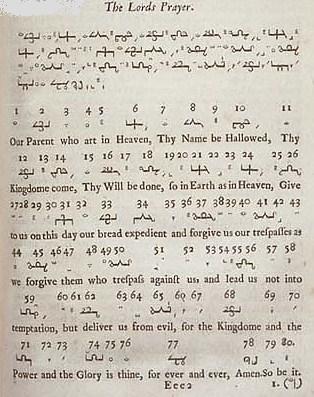 |
| A sample of Wilkins' Real Character |
It's difficult to define the exact boundaries of what does and doesn't qualify as a philosophical language - the definition has something to do with the creator's intention as well as the actual structure of the language. Generally, a philosophical language is one engineered with major structural differences from natural languages, which are meant to reflect the creator's philosophy of how communication and the synthesis of meaning could or should work. They may or may not, though often do, come with implicit assertions that the language has the power to improve or bring clarity to the human condition. Much to the chagrin of many a philosophical language maker, the very things that make them special also tend to irreparably impair their potential as practical communication tools for real people. What do I mean? As always, a few examples might help paint a picture.
The first vogue of philosophical languages was the idea of a taxonomic language, one in which every concept in the world is defined by its place in a taxonomic hierarchy, and words get longer and longer to express more and more specificity about a smaller and smaller branch on the tree. For instance, in John Wilkins' Real Character, zi means "mammal," zit is "canine," and zita is the domestic dog. The 17th century saw a succession of these, mostly composed by a community of authors, who eventually realized the fundamental impossibility of the project. Even so, people continue to attempt them, usually unaware of past failures.
An idea similar to the classifying language, which crops up with fair frequency among novice conlangers, is the oligosynthetic language - one which uses a finite, usually quite small set of elementary concepts as building blocks to synthesize more complex meanings. It's easy to see the appeal of a taxonomic or oligosynthetic language - they seem to promise to be logical, precise, and easy to learn. As it turns out, though, there are a couple of major stumbling blocks for practical use:
The first is that words with similar meanings sound similar - often, the terms for related concepts like specific colors or species of mammals differ by only one letter. At first blush that sounds okay and reasonable but, on closer inspection, flies in the face of what humans really do when they talk. We are born kings and queens of context and relevance, and usually have a good idea what general conceptual field is being talked about. It's thus far more often that we need to distinguish between two very similar ideas than two very different ones, but if most of a word is spent defining the type of concept, the speaker is just wasting breath telling what the listener already knows, and the most important bit of the word is small enough to be easily missed.
The first is that words with similar meanings sound similar - often, the terms for related concepts like specific colors or species of mammals differ by only one letter. At first blush that sounds okay and reasonable but, on closer inspection, flies in the face of what humans really do when they talk. We are born kings and queens of context and relevance, and usually have a good idea what general conceptual field is being talked about. It's thus far more often that we need to distinguish between two very similar ideas than two very different ones, but if most of a word is spent defining the type of concept, the speaker is just wasting breath telling what the listener already knows, and the most important bit of the word is small enough to be easily missed.
The second, and perhaps more obvious, is that an absolute classification of the concepts of the world is impossible - any scheme is necessarily riddled with cultural bias and arbitrary decisions. The choice of how to represent a given concept ultimately has to be memorized, and might even be a source of active disagreement.
In more recent times, some well-known philosophical language projects have emerged that are constructed along different precepts (though there are plenty of taxonomic and oligosynthetic languages still manufactured as well), usually coming with a smaller dose of vanity. Suzette Haden Elgin's Láadan attempted to represent the perspective of women, though the author herself concluded that it was a failure. Several so-called logical languages like Ithkuil and Lojban have also been produced, which attempt to eliminate various types of syntactic ambiguity and imprecision.
Further reading:
500 Word Answers: Conling - What Constitutes A Philosophical Language? >>>>> Download Now
ReplyDelete>>>>> Download Full
500 Word Answers: Conling - What Constitutes A Philosophical Language? >>>>> Download LINK
>>>>> Download Now
500 Word Answers: Conling - What Constitutes A Philosophical Language? >>>>> Download Full
>>>>> Download LINK